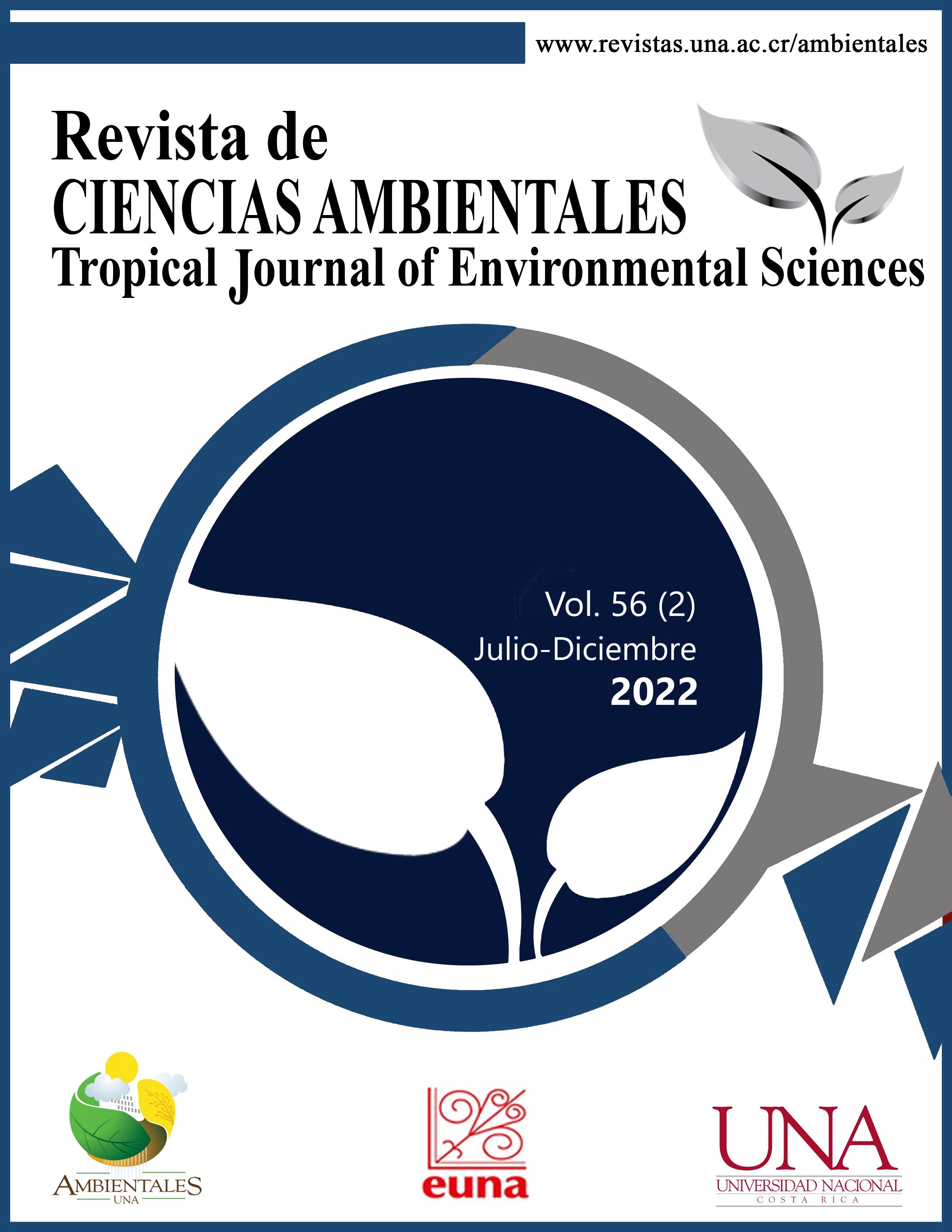Estimates of jaguar (Panthera onca) population density in the South American Greater Madidi-Tambopata Landscape
DOI:
https://doi.org/10.15359/rca.56-2.1Keywords:
Bolivia; camera traps; capture-recapture; maximum average distance; Peru.Abstract
Abstract
[Introduction]: The jaguar (Panthera onca) is the largest feline in the Americas, and due to vast connected forests the Amazon currently holds the largest jaguar populations. [Objective]: We present jaguar population density estimates for seven sites in the Great Madidi-Tambopata Landscape in northwestern Bolivia and southeastern Peru. [Methodology]: Data collection occurred from 2001 to 2008, using between 26 to 118 camera trap stations distributed in polygons between 37 to 355 km2 of sampled area, active from 29 to 75 days at each study site. [Results]: We identified a total of 63 individuals across all sampling sites. The estimated capture rate for each sampling site ranged from 0.18 to 2.81 independent events/100 trap nights. Jaguar density estimates with SCR models ranged from of 0.1 to 2.39 individuals/100 km2, and derived CAPTURE (MMDM) population density estimates using a regional buffer (5.76 km, n = 19), were between 0.52 and 2.86 individuals/100 km2. [Conclusions]: These results are especially relevant for the development of conservation strategies and evaluations for this threatened species, and also underline the importance of the transboundary Greater Madidi-Tambopata Landscape as a population stronghold for jaguars in the region.
References
Cavalcanti, S. & Gese, E.M. (2009). Spatial ecology and social interactions of jaguars (Panthera onca) in the southern Pantanal, Brazil. Journal of Mammals, 90(4), 395-945. https://doi.org/10.1644/08-MAMM-A-188.1
Conservación Internacional Perú (1999). Complejidad y Fragilidad, la conservación y la exploración petrolera en Tambopata-Candamo. CI - Perú ediciones. Lima, Peru.
Cullen, Jr. Abreu, L. K. C., Sana, D. & Nava, A. F. D. (2005). Jaguars as landscape detectives for the upper Parana river corridor, Brazil. Natureza e Conservacao, 3, 43-58. https://www.researchgate.net/publication/282186446_Jaguars_as_landscape_detectives_for_the_upper_Parana_River_corridor_Brazil
Cuyckens, G. A. E., Perovic, P.G. & Herrán, M. (2017). Living on the edge: regional distribution and retracting range of the jaguar (Panthera onca). Animal Biodiversity and Conservation, 40(1), 71-86. https://doi.org/10.32800/abc.2017.40.0071
De la Quintana, D. (2005). Diversidad florística y estructura de una parcela permanente en un bosque amazónico preandino del sector del Río Hondo, Área Natural de Manejo Integrado Madidi (La Paz, Bolivia). Ecología en Bolivia, 40, 418-442. https://ecologiaenbolivia.com/documents/16Hondo40-3.pdf
Fuentes, A. (2005). Una introducción a la vegetación de la región de Madidi. Ecología en Bolivia, 40,1-31. http://www.mobot.org/MOBOT/Research/madidi/pdf/02Introduccin40-3.pdf
Ibisch, P. L., Beck, S. G., Gerkmann, B. & Carretero, A. (2003). Ecorregiones y ecosistemas. In: P. L. Ibisch & G. Mérida (Eds.), Biodiversidad: La Riqueza de Bolivia. Estado de Conocimiento y Conservación. (pp. 47–53). Editorial FAN. https://www.researchgate.net/publication/328028130_Biodiversidad_-_riqueza_de_Bolivia#:~:text=En%20Bolivia%20se%20encuentra%20un,es%20imprescindible%20para%20su%20supervivencia.
Jędrzejewski, W., Robinson, H. S., Abarca, M., Zeller, K. A., Velasquez, G., Paemelaere E. A. D., Goldberg, J. F., Payan, E., Hoogesteijn, R., Boede, E. O., Schmidt, K., Lampo, M., Viloria, A. L., Carreño, R., Robinson, N., Lukacs, P. M., Nowak, J. J., Salom-Perez, R., Castañeda, F., Boron, V. & Quigle, H. (2018). Estimating large carnivore populations at global scale based on spatial predictions of density and distribution - Application to the jaguar (Panthera onca). PLoS ONE, 13(3), e0194719. https://doi.org/10.1371/journal.pone.0194719
Maffei, L., Cuéllar, E. & Noss, A. (2004). One thousand jaguars (Panthera onca) in Bolivia's Chaco? Camera trapping in the Kaa-Iya National Park. Journal of Zoology, 262(3), 295-304. https://doi.org/10.1017/S0952836903004655.
Maffei, L., Polisar, J., García, R., Moreira, J. & Noss, A. (2011). Perspectives from ten years of jaguar (Panthera onca) camera trapping in Mesoamerica. Mesoamericana, 15(1), 49-59. https://www.researchgate.net/publication/269709076_Perspectives_from_ten_years_of_jaguar_Panthera_onca_camera_trapping_in_Mesoamerica_Perspectivas_de_diez_anos_de_estudios_con_trampas_camara_de_jaguares_Panthera_onca_en_Mesoamerica
Mena, J. L., Yagui, H., Tejeda, V., Cabrera, J., Pacheco-Esquivel, J., Rivero, J. & Pastor, P. (2020). Abundance of jaguars and occupancy of medium- and large-sized vertebrates in a transboundary conservation landscape in the northwestern Amazon, Global Ecology Conservation, 23 e01079. https://doi.org/10.1016/j.gecco.2020.e01079.
Miller, C. M. & Miller, B. (2005). Jaguar density in La Selva Maya. Report. Wildlife Conservation Society, Gallon Jug, Belize.
Morcatty, T., Macedo, J. C. B., Nekaris, K. A. I., Ni, Q., Durigan, C., Svensson, M. S. & Nijman, V. (2020). Illegal trade in wildcats and its link to Chinese‐led development in Central and South America. Conservation Biology, 34(6), 1525–1535. https://doi.org/10.1111/cobi.13498.
Moreira, J., McNab, R.B., García, R., Méndez, V., Ponce-Santizo, G., Córdova, M., Tun, S., Caal, T., & Corado, J. (2008). Densidad de Jaguares en el Biotopo Protegido Dos Lagunas, Parque Nacional Mirador Río Azul, Petén, Guatemala. Wildlife Conservation Society. Flores, Guatemala. 1-21. https://docplayer.es/60147300-Densidad-de-jaguares-en-el-biotopo-protegido-dos-lagunas-parque-nacional-mirador-rio-azul-peten-guatemala.html
Negrões, N., Arise, R., Asturizaga, K., Barboza, K., Fonseca, C., Ten, S., & Terán, M. (2016). Conflicto con jaguar (Panthera onca) en Bolivia: del daño al ganado a la percepción de riesgo. In: C. Castaño-Uribe, C.A. Lasso, R. Hoogesteijn & E. Payán-Garrido (Eds.), II Conflicto entre felinos y humanos en América Latina. (pp. 327-338). Serie Editorial Fauna Silvestre Neotropical. https://www.researchgate.net/publication/318043932_Conflictos_con_jaguar_Panthera_onca_en_Bolivia_del_dano_al_ganado_a_la_percepcion_del_riesgo
Noss, A., Gardner, B., Maffei, L., Cuéllar, E., Montaño, R., Romero-Muñoz, A., Sollman, R. & O’Connell & Jr. A. F. (2012). Comparison of density estimation methods for mammal populations with camera traps in the Kaa-Iya del Gran Chaco landscape. Animal Conservation, 15, 527-535. https://doi.org/10.1111/j.1469-1795.2012.00545.x
Noss, A., Polisar, J., Maffei, L., García-Anleu, R. & Silver, S. (2013). Evaluating jaguar densities with camera traps. Wildlife Conservation Society, 1-78 https://www.researchgate.net/publication/269709284_Evaluating_jaguar_densities_with_camera_traps
Nuñez, A. & Aliaga-Rossel, E. (2017). Jaguar fangs trafficking by Chinese in Bolivia. Catnews, 65, 50-51. https://www.academia.edu/35119589/Jaguar_fangs_trafficking_by_Chinese_in_Bolivia
O’Brien, T. G., Kinnaird, M. F. & Wibisono, H. T. (2003). Crouching tigers, hidden prey: Sumatran tiger and prey populations in a tropical forest landscape. Animal Conservation, 6, 131-139. https://doi.org/10.1017/S1367943003003172
Otis, D. L., Burnham, K. P., White, G. C. & Anderson, D. R. (1978). Statistical inference from capture data on closed populations. Wildlife Monographs, 62, 1-135. https://nwrc.contentdm.oclc.org/digital/collection/NWRCPubs1/id/10701
Paviolo, A. J., De Angelo, C. D., Di Blanco, Y. E. & Di Bitetti, M. S. (2008). Jaguar Panthera onca population decline in the Upper Parana Atlantic Forest of Argentina and Brazil. Oryx, 42(4), 554-561. https://doi.org/10.1017/S0030605308000641
Porfirio, G., Sarmento, P., Leal, S. & Fonseca, C. (2016). How is the jaguar Panthera onca perceived by local communities along the Paraguai River in the Brazilian Pantanal? Oryx, 50(1), 163-168. https://doi.org/10.1017/S0030605314000349
Quigley, H., Foster, R., Petracca, L., Payan, E., Salom, R. & Harmsen, B. (2017). Panthera onca, The IUCN Red List of Threatened Species 2017: e.T15953A123791436. https://dx.doi.org/10.2305/IUCN.UK.2017-3.RLTS.T15953A50658693
Rabinowitz, A. R. & Nottingham, B. G. Jr. (1986). Ecology and behavior of the jaguar (Panthera onca) in Belize, Central America. Journal Zoology, 210, 149-159. https://doi.org/10.1111/j.1469-7998.1986.tb03627.x
Rexstad, E. & Burnham, K. P. (1992). User’s guide for interactive program CAPTURE. Abundance estimation of closed populations. Colorado State University, Fort Collins, Colorado, USA. https://www.mbr-pwrc.usgs.gov/software/doc/capturemanual.pdf
Ribera, M. O. (1992). Regiones Ecológicas Capitulo II. In: M. Marconi (Eds.) Conservación de la Diversidad Biológica en Bolivia. 9-71. CDC USAID. La Paz, Bolivia.
Romero-Muñoz, A., Benítez-López, A., Zurell, D., Baumann, M., Camino, M., Decarre, J., Castillo, H., Giordano, A. J., Gómez-Valencia, B., Levers, C., Noss, A. J., Quiroga, V., Thompson, J. J., Torres, R., Velilla, M., Weiler, A. & Kuemmerle, T. (2020). Increasing synergistic effects of habitat destruction and hunting on mammals over three decades in the Gran Chaco. Ecography, 43(7),1-13. https://dx.doi.org/10.1111/ecog.05053
Royle, J. A., Chandler, R. B., Gazenski, K. D. & Graves, T. A. (2013). Spatial capture-recapture models for jointly estimating population density and landscape connectivity. Ecology, 94(2), 287-294. https://doi.org/10.1890/12-0413.1
Sanderson, E.W., Redford, K.H., Vedder, A., Ward, S.E. & Coppolillo, P. B. (2002). A conceptual model for conservation planning based on landscape species requirements. Landsc Urban Plan, 58, 41-56. https://doi.org/10.1016/S0169-2046(01)00231-6
Silveira Silveira, L., Jácomo, A. T. A., Astete, S., Solmann, R., Tôrres, N. M., Furtado, M. M. & Marinho-Filho, J. (2010). Density of the near threatened jaguar Panthera onca in the Caatinga for north-eastern Brazil. Oryx, 44(1), 104-109. https://doi.org/10.1017/S0030605309990433
Silver, S. C., Ostro, L. E. T., Marsh, L. K., Maffei, L., Noss, A.J., Kelly, M. J., Wallace, R. B., Gómez, H. & Ayala, G. (2004). The use of camera traps for estimating jaguar Panthera onca abundance and density using capture/recapture analysis. Oryx, 38, 148-154. https://doi.org/10.1017/S0030605304000286
Soisalo, M. K. & Cavalcanti, S. M. C. (2006). Estimating the density of a jaguar population in the Brazilian Pantanal using camera-traps and capture-recapture sampling in combination with GPS radio-telemetry. Biological Conservation, 129, 487-496. https://doi.org/10.1016/j.biocon.2005.11.023
Sunquist, M. E. & Sunquist, F.C. (2002). Wild Cats of the World. Chicago: The University of Chicago. Chicago, USA. https://www.conservationcatalyst.com/cats-of-the-world
Sutherland, C., Royle, J. A. & Linden, D.W. (2019). oSCR: a spatial capture–recapture R package for inference about spatial ecological processes. Ecography, 42, 1459-1469. https://doi.org/10.1111/ecog.04551
Thompson, J. J., Martinez, C. & Quigley, H. (2020). Anthropogenic factors disproportionately affect the occurrence and potential population connectivity of the Neotropic’s apex predator: The jaguar at the southwestern extent of its distribution. Global Ecology and Conservation, 1-12. https://doi.org/10.1016/j.gecco.2020.e01356
Thornton, D., Zeller, K., Rondinini, C., Boitani, L., Crooks, K., Burdett, C., Rabinowitz, A. & Quigley, H. (2016). Assessing the umbrella value of a range-wide conservation net-work for jaguars (Panthera onca). Ecological Applications, 26 (4), 1112-1124. https://doi.org/10.1890/15-0602
Tobler, M. W. & Powell, G. V. N. (2013). Estimating jaguar densities with camera traps: Problems with current designs and recommendations for future studies. Biological Conservation, 159, 109-118. https://doi.org/10.1016/j.biocon.2012.12.009
Tobler, M., Carrillo-Percastegui, S., Zúñiga, A. & Powell, G. (2013). High jaguar densities and large population sizes in the core habitat of the southwestern Amazon. Biological Conservation, 159, 375-381. https://doi.org/10.1016/j.biocon.2012.12.012
Wallace, R. B., Gómez, H., Ayala, G. & Espinoza, F. (2003). Camera trapping capture frequencies for jaguar (Panthera onca) in the Tuichi Valley, Bolivia. Mastozoología Neotroprical, 10, 133-139. https://www.redalyc.org/pdf/457/45710110.pdf
Downloads
Published
How to Cite
Issue
Section
License

This work is licensed under a Creative Commons Attribution-NonCommercial-ShareAlike 4.0 International License.



















